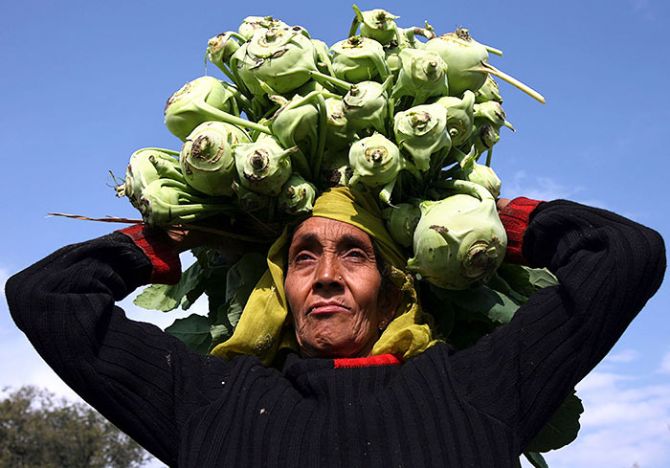Women's share of work in these industries is over 50 per cent, yet they are paid much less than their male counterparts.
It is time to stamp out the gender disparity, says Surinder Sud.

Photograph: Mukesh Gupta/Reuters
Look at this.
Women comprise 30.3 per cent of the total cultivators and 42.7 per cent of agricultural labour (2011 Census).
Nearly 24 per cent of fish farmers are women.
In as many as 23 of the 29 states, women's share in the total workforce in agriculture, forestry and fisheries is over 50 per cent.
In states such as Chhattisgarh, Bihar and Madhya Pradesh, this share exceeds 70 per cent.
Typically, their contribution to agriculture is more in hilly regions than in the plains.
In the case of different farming activities, their participation is 47 per cent in cotton and tea cultivation, 39 per cent in vegetable production, 51 per cent in post-harvest handling of farm produce and 58 per cent in livestock rearing.
They handle all kinds of jobs ranging from crop sowing to irrigation, fertiliser application, weed removal and crop harvesting.
They are also actively engaged in livestock rearing, fodder collection, beekeeping, mushroom cultivation, poultry and similar other fields.
Yet, women are grossly discriminated against in several respects.
They are invariably paid less than the male workers -- mostly 60 per cent of what men earn.
They lack ownership of property, the land being rarely in their names.
They have little say in decision-making.
They are not often the members of cooperative societies.
Most strikingly, they have little access to cheaper credit and other agriculture-related sops, which are usually linked to land ownership.
Worse still, they are the victims of ill-treatment at homes, though such abuse seems to be the least in case of women, who own land or other property. A study has indicated that 84 per cent of non-property-owning females faced psychological abuse, with 49 per cent of them being subjected to physical violence as well.
Gender disparity in farm work varies from state to state and seems to be relatively less in the hilly areas where agriculture relies heavily on females. This is revealed by the 'Gender Work Participation Disparity Index' prepared by the Bhubaneswar-based Central Institute of Women in Agriculture (CIWA).
The index value for Nagaland, Manipur and Himachal Pradesh is less than 0.15, which indicates the least gender inequality in work. On the other hand, states such as Punjab, Haryana, Kerala, Uttar Pradesh, Bihar and Odisha have relatively high gender work participation disparity, with the index value ranging from 0.34 to 0.59.
The CIWA has also developed a 'General Knowledge System Portal' to provide all the information on gender-friendly technologies, statistics, publications and official schemes related to farm women. Once fully operational, it will become a single-window knowledge source on gender-related matters for policymakers, researchers, extension workers and others. It is also likely to be useful for the country's 680 Krishi Vigyan Kendras (agricultural science centres), which are training women in various income-generating pursuits.
In 2016-17, these centres promoted 21 different women-oriented technologies aimed at reducing drudgery; improving nutrition and family health; storing, processing and adding value to farm produce; and conserving energy.
Other significant activities taken up under this programme include mushroom cultivation, vermi-compost production and setting up of nutrition gardens.
This apart, about 256,000 women were trained in typical agri-rural fields such as integrated farming, plant nursery management, protected cultivation of vegetables and post-harvest handing of farm produce, besides rural handicrafts, tailoring and stitching.
All these efforts are targeted, directly or tacitly, at economic empowerment of women.
Fortunately, the agriculture ministry, too, is turning gender-sensitive and taking positive steps to promote the welfare of farm women.
It has begun to encourage leasing of agricultural and domestic land in joint names.
Kisan Credit Cards are being issued to women to enable them to access cheap bank credit.
Women are being motivated to form self-help groups to deal with microfinance.
Most importantly, 30 per cent of funds are being set apart for women under the various schemes run by the ministry.
However, this is only a small beginning. Much more needs to be done to stamp out gender disparity through women empowerment.












 © 2025
© 2025